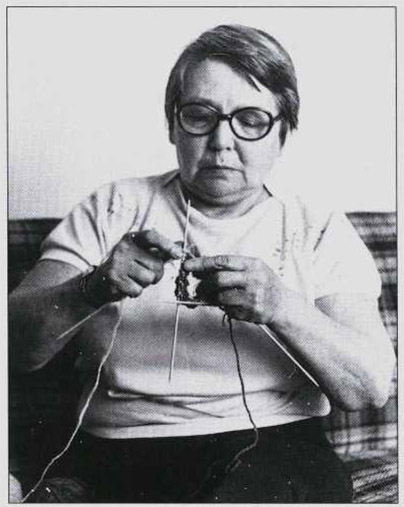
In Newfoundland and Labrador, the style of mittens changes radically from the allover patterns knit in Maine, New Brunswick, and Nova Scotia. A blending of traditions—Norwegian, Channel and Shetland Islands, Irish and Scottish—results in something different and special.
Knitting in two colors is not called double-knitting here, but two-ball knitting, or double-ball knitting. The pattern doesn’t wrap around the mitten but is confined to the back of the mitten or glove, with the rest usually knitted in Salt and Pepper pattern.
In Newfoundland, mittens are called cuffs, mitts, or sometimes thumbies (Pocius, Textile Traditions of Eastern Newfoundland, 1979) and knitting needles are called skivvies.
Sometimes the pattern is markedly Scandinavian. The Selby Star that one sees everywhere on Norwegian mittens shows up here too—apparently lifted intact from a Norwegian knitting book and dropped into the folk medium in Newfoundland—and a reindeer pattern from the same book is commonly knitted throughout the area and known as Deer or Caribou.
Then again, a mitten may have one of many patterns of checks or diamonds that knitters seem fond of here, or waves, running either lengthwise or across the hand. Sometimes it is a combination—a Norwegian eight-pointed star with diamonds as the fill between the points of the star, or a checked pattern with a striped thumb and fleur-de-lis on the palm. The wave and diamond paterns are featured on the mittens in the following pages.
In this region, more often than anywhere else in Maine and Atlantic Canada, the index finger will be separated or the hand covering will be a complete glove with all the fingers separate. Sometimes the ends of the mitten are rounded, as they are farther south; other mittens, the ones with a strong Norwegian look, have the pointed Norwegian hand and thumb tips.

Harriet Pardy Martin, whose interview with her daughter Doris Saunders in Them Days magazine is the basis for most of the mittens in this section.
PHOTOGRAPH COURTESY OF THEM DAYS MAGAZINE
Knitting mitts and socks and hand spinning the wool of one’s own sheep are still viable home crafts in Newfoundland and Labrador, and many families maintain traditional patterns. Knitters also play with patterns, changing a stitch here or there, taking a little of the drudgery out of necessary, constant knitting. Every pair of Diamond mitts seems to be different.
Although Newfoundland folklorist Jerry Pocius wrote that knitting in Newfoundland is now mainly recreational—a hobby—the fact that almost everyone owns a pair of two-ball mittens or gloves shows the importance of handknitting here in contrast to New England, New Brunswick, and Nova Scotia, where whole communities have forgotten the skill of double-knitting wool mittens or turning the heel of a sock.